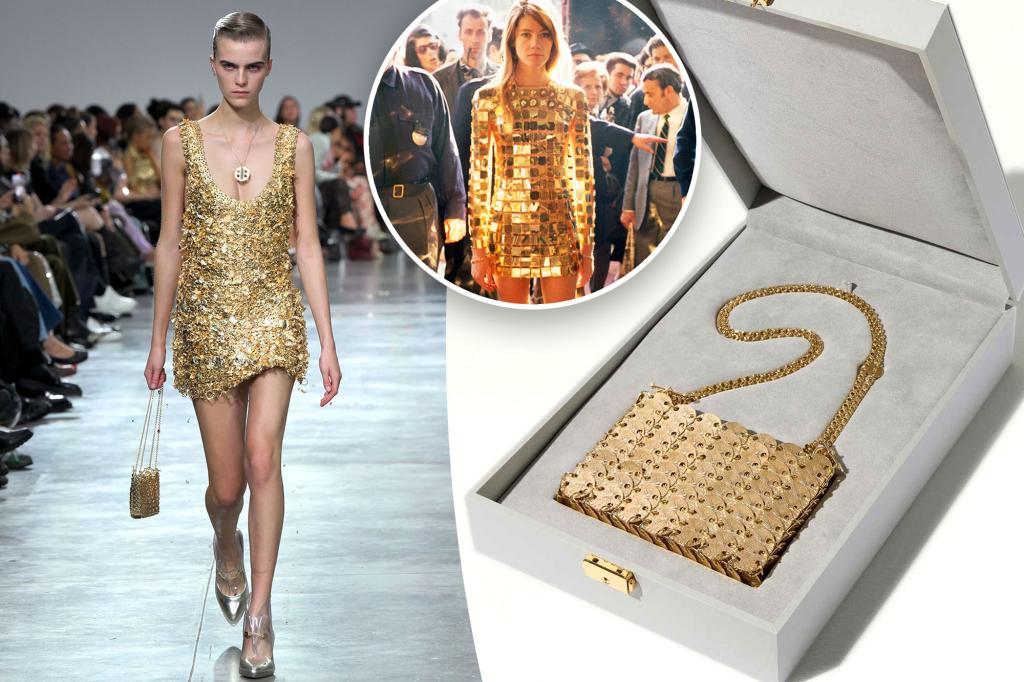At Paris Fashion Week, Rabanne debuted what has been called the world’s most expensive bag, the 1969 Nano bag, made from over 100 18-karat gold medallions. Created in collaboration with French jeweler Arthus Bertrand, the handcrafted bag is valued at €250,000, or nearly $280,000, and took 100 hours to create. The bag is a nod to the fashion house’s most expensive dress from 1968, worn by French singer Francoise Hardy, made with 1,000 gold tiles and 300 carats of diamonds, with a full security escort and armored vehicle. The bag is a fusion of the Rabanne pastille twisted into a medal, according to Arthus Bertrand’s artistic director, Camille Toupet.
Paco Rabanne, the founder of the fashion house known for his innovative designs using unconventional materials like paper, plastic, and metals, launched his atelier with a collection of “unwearable dresses.” The fashion house incorporated playful elements in its accessories during Paris Fashion Week, with unusual textiles like leather bags covered in clear, rigid plastic and pumps enveloped in transparent fabric. The spring/summer 2025 collection also featured pieces paying homage to the iconic metalwork with sparkling triangular panels and garments covered in metal studs. The runway show, attended by rapper Cardi B and featuring model Gigi Hadid, showcased the house’s experimentation with materials and design.
It remains unclear if the gold 1969 Nano bag will be for sale or if multiple pieces have been created. The Post reached out to Rabanne, now owned by Puig, for comment. Alongside the gold bag, Rabanne also debuted two new handbags for its spring/summer 2025 collection, the 1969 Ceramic Bag made of ceramic discs from Astier de Villatte, and the 1969 Glass Bag made of Murino glass medallions by Venini. These handbags will be available for order at the Paris Rabanne boutique. Julien Dossena, Rabanne’s creative director, spoke highly of the exceptional pieces that were created for the collection, including the ceramic and glass bags.
The 1969 Nano bag is a statement piece that continues the legacy of Paco Rabanne as an innovator in space-age fashion. The bag’s intricate design, made from 18-karat gold medallions and crafted over 100 hours, reflects the fashion house’s dedication to luxury and craftsmanship. The bag’s debut at Paris Fashion Week alongside other experimental designs and playful elements in the collection showcases Rabanne’s commitment to pushing boundaries in fashion. The fusion of the Rabanne pastille into a medal in collaboration with Arthus Bertrand represents a seamless partnership between two iconic houses.
The 1969 Nano bag and other handbags from the spring/summer 2025 collection capture the essence of Rabanne’s avant-garde approach to fashion. With pieces made from ceramic discs and Murino glass medallions, the collection represents a fusion of traditional craftsmanship with modern design. Rabanne’s history of using unconventional materials is evident in the collection’s playful accessories, which incorporate elements like clear plastic, metal studs, and unique textiles. The fashion house’s ability to blend luxury with innovation is showcased in the 1969 Nano bag and the other handbags introduced during Paris Fashion Week.
Overall, Rabanne’s debut of the 1969 Nano bag at Paris Fashion Week demonstrates the fashion house’s commitment to creativity, craftsmanship, and luxury. The collaboration with Arthus Bertrand, the use of 18-karat gold medallions, and the intricate design of the handbag reflect Rabanne’s legacy as a pioneer in innovative fashion. The collection’s incorporation of playful and avant-garde elements, alongside traditional materials like ceramic and glass, highlights the brand’s ability to combine the past with the present in a unique and cohesive way. Rabanne’s ongoing legacy as an iconic fashion house is reaffirmed through the unveiling of the world’s most expensive bag in Paris.


